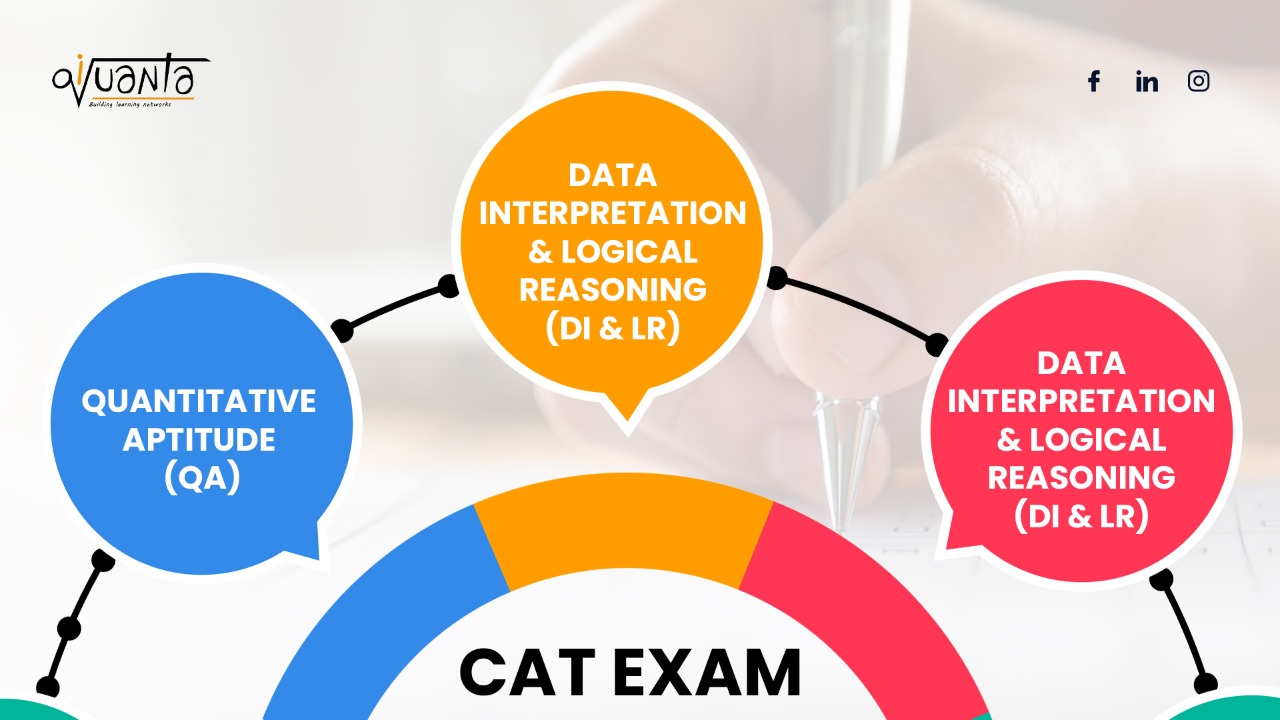CAT Exam Preparation Strategy
The CAT entrance exam is the most popular entrance exam, a gateway to 20 IIMs and over 1200 B-schools in India. A proper CAT strategy requires the candidate’s general aptitude, analytical abilities, and problem-solving skills, essential for a manager. This is why having a CAT preparation strategy is important. Patience is crucial for the preparation for any competitive exam.
If anyone wants to crack this exam, they must be consistent throughout the journey. Also, to crack this exam, you don’t have to answer all the questions. If you answered just 42% of the whole questions correctly, it is enough to get you a call from IIMs and other non-IIMs.
CAT test is divided into 3 sections.
- Quantitative Aptitude (QA)
- Data Interpretation & Logical Reasoning (DI & LR)
- Verbal and Reading Comprehension (VARC)

Section-wise CAT Preparation Strategy
Understanding the CAT exam syllabus is crucial before you directly jump into your preparation. After that, analyse the paper pattern by referring to the CAT Past year papers. This analysis will help you identify your weak and strong areas. Using this information, you will understand which area will require more effort from your side.
If you are wondering why you may not be able to solve all the questions, keep in mind that you can master any topic in the CAT syllabus with sufficient practice. For example, quantitative ability is an area found to be most difficult by aspirants from non-engineering backgrounds. Just focus on clearing your basics, then subsequently move on to the trickier concepts; with sufficient practice and the proper CAT preparation strategy, you can easily score 99+ percentile.
It might take you a lot of time to solve the questions at first but always remember that first you need to work on your accuracy, and with adequate practice, you’ll automatically start taking less time to crack the solution. Solve previous year’s CAT exam papers to get an idea of what kinds of questions you’ll be facing.
Once you are confident enough to solve all types of questions from a topic, start appearing for mocks and analyse them. Mocks are very important as taking them will get you into a habit of sitting for a 2 to 3-hour exam. They are also very important to figure out your weaknesses, and once you spot them, you should give them more attention.
Quantitative Ability
This, I suppose, is the most favourite section for someone and the most difficult section for others who think they are very weak in mathematics. Start by brushing up your basics up to the Secondary level School syllabus.
Get a basic understanding of all topics and solve the question bank provided by iQuanta. Don’t leave any topic as you can get an easy question out of anyone. If you are not comfortable with some topic, just read its basics to solve conceptual problems. It is the most diverse area in the paper, and there are a lot of concepts involved. Hence one must be thorough with almost 95% of them. If the basics are strong, getting 99%ile + is easier for aspirants with a proper CAT preparation strategy.
Strategy for Quantitative Ability:
- The major focus should be on arithmetic as it consists of many questions then followed by algebra, geometry, number system and modern maths.
- Don’t leave any topic as in CAT 2021; there were 2-3 questions from PNC, so prepare for every topic that is in the CAT exam syllabus.
- Work on calculations so that you can solve basic calculations within seconds. So learn tables and squares of numbers, and you will see that this will definitely increase the speed of solving.
- There are two approaches while solving a question: general and shortcut way. If you apply the general method, you will not be able to solve all the questions in time. Also, you can solve by using options, but it only works when you have practised lots of questions and have a clear idea of doing it through options.
- Solve as many questions from every topic, and try to be familiar with all the types of questions by practising lots of varieties.
Logical Reasoning & Data Interpretation
This section is considered to be the trickiest as there is no definite syllabus for this one, and it is very unpredictable. The last few years have seen a significant increase in the difficulty level of LRDI questions in CAT. This section is highly unpredictable in CAT as anything which requires logic and interpretation skills can appear. A well-researched strategy for CAT preparation is required.
This is a section that improves with practice. All beginners must go through the past year’s papers to get an idea of the kind of questions asked in the exam. Learn some basics of Tables, Charts and Caseletes. This section demands 35 to 40% of the questions to be corrected in CAT to fetch the 99 percentile.
Comparatively, the older LRDI sets in the CAT exam paper used to be much easier than now. All you can do for the preparation is to practice as many sets as possible. Solve as many previous year papers as possible and appear for mocks. This will help you gain familiarity with the level of CAT and what you’re going to deal with. If you solve 300-400 LRDI sets in the entire duration of your preparation, it can help you solve at least 4 out of 8 LRDI sets that can easily get you 99%ile!
Logical Reasoning includes puzzles that need basic common sense. Indeed, puzzles can be too random at times, but there are some standard LR question types seen more often than others. Most important among them are the LR sets involving the arrangement of data in a tabular structure.
CAT Preparation Strategy for LRDI:
Solve as many questions as possible from the question bank.
You can start slow and eventually solve at least 4 sets daily comprising of different varieties and be consistent with it.
Make yourself comfortable with diagrams like in seating arrangement, network flow diagram, 4 Set Venn diagram, et cetera. You also need to know every type of graph in the DI section, like the Stacked graphs, Line chart graphs, Layered pie charts, et cetera.
Do not write excessive information and avoid reading the information again and again while solving as it will lead to confusion and silly mistakes. The focus should be on solving the question. This is why it’s very important to build some logic through regular solving puzzle-based questions.
Solve the maximum number of sets as you can in both data interpretation and logical reasoning. You should be familiar with all the types of sets for an effective strategy for the CAT exam.
Verbal Ability and Reading Comprehension (VARC)
Reading Comprehension: Subscribe to a daily newspaper and/or a weekly news magazine: 70% of the Verbal Ability section in a typical CAT exam paper comprises Reading Comprehension passages. This section requires a regular reading habit from the candidates. So, get into a habit of reading online articles of different genres or newspapers from any source. Reading different genres will help you get familiar with various topics that could be brought up for RCs. You’ll see that the RCs on familiar topics seem to be easier than the unknown ones. So it is important to have variation in your reading.
After a regular reading habit, you can now start focusing on your speed. Various online sites can determine your reading speed. RCs require more practice in your reading skills. Start by solving 1–2 RCs a day and then gradually them after you start gaining confidence. Try to analyse the tone and the passages. It will eventually come with time.
Indeed, even if you solve only RC with an accuracy of 70% (very achievable), you will comfortably clear your VA cut-offs without even having to touch the dreaded grammar section. This is why RCs should be a major part of your CAT preparation strategy.
Vocabulary: You can start by learning 1-2 words daily. Focus on words that are mostly used in articles and come in CAT RC’S regularly; you will benefit a lot when you can decode the meaning by knowing the actual meaning of that word.
Verbal Ability: Practice as many previous year papers for the verbal section as you can. It mainly consists of topics like Para-jumbles, Para-summaries, Odd One Out, etc. After you’ve gained at least 80-90% accuracy with the questions and RCs, start appearing for mocks and analyse them so that you can figure out and work out your weaknesses.
VA has 3 sections:
- Word level: Synonyms, Antonyms, Odd one out, Idioms and Phrases etc. (minimal to negligible weightage)
- Sentence level: Fill in the blanks, Errors, Cloze test etc. (minimal to negligible weightage)
- Paragraph level: Para jumble, Critical reasoning and Para summary etc (major weightage)
Usually, Para jumble, Para summary and Odd one out are asked in the CAT exam but prepare all these because it helps in other exams like SNAP, IIFT and NMAT, XAT, etc. If you are done with these, start practising RC’S there are a lot of good sources, but reading has to be constant all the time with practising:
Please consider this section as important as the other two. It will also benefit you in LRDI while comprehending the difficult sets. Also, keep practising the RCs. Take as much time as you need but get them all correct.
Overall CAT preparation strategy –

These were some of the tips that are usually followed for the CAT exam. But it is recommended that you personalise them according to your study pace and goals.
Mocks: this is one of the biggest mistakes that aspirants commit themselves to—either they do not attempt mocks seriously, or even if they do, they do not analyse their performance. It is recommended that you give at least 30-40 mocks and properly analyse them, this will help you guide and modify your strategy.
As scoring good in all 3 sections is important, proper time allocation for each section is very important. You can do as listed below:
- 30 minutes a day of reading + VA practice
- 2 Quant concepts a day (theory)
- 1-2 LRDI sets per day
- 20 questions for quantitative ability practice.
5. 1-2 RC sets per day
How to schedule your time for CAT Exam?
-
Making a schedule
If you are a college student, aim for a minimum of 3 hours of daily focused study to stay in the competition. Try to complete your syllabus as early as possible to get sufficient time in the end to practice mocks and revise your concepts.
Try to use the shortcuts and tricks instead of the general methods, iQuanta will take care that you are able to solve questions as quick as possible in the CAT exam. You can join iQuanta’s CAT Preparation Facebook group to get 24×7 doubt solving and create your own study that will help you discuss problems, share your queries and strategies, and help you prepare better.
iQuanta offers a flexible learning pattern that can be done from anywhere, at any time. You can designate as many hours as per your convenience and study from the comforts of your home. Even those working during the day can opt for iQuanta’s 2023 course and educate themselves.
For an effective CAT preparation strategy, give each section equal importance. For Quants, practice and remember the tricks and strategies used for the particular type of question. Get your concepts cleared. For VARC, increase your reading speed and English proficiency, and try to understand and resonate with the thoughts portrayed in the paragraph. For DI, understand the topic with examples and practice till your concepts are crystal clear. Don’t try to mug up any topic.
Since you have more than enough time to prepare for the CAT exam in 2023, you can focus on building up your profile for now. You can develop habits that would help you in the long run, like reading newspaper articles and novels, focusing on your academics, and doing all that would help you land a top B-school. I recommend reading as it will help you a lot in doing RCs. Focus is the key to preparing for the CAT exam or any other competitive exam.
First and foremost, you need to get your basic concepts clear. The CAT syllabus comprises what you’ve studied from classes 6th to 10th.
iQuanta CAT Course offers the following benefits in your CAT Preparation Strategy:

(Discount Code at the end, only for the first 50 students, visit www.iQuanta.in to enrol)
iQuanta offers the most impactful learning method for the CAT test with iQuanta’s unique Dual Pedagogy.
Our Students get Live Conceptual Videos along with Live Application sessions, with Doubt Solving & Counselling. We have over 1500 Conceptual Videos and EXCLUSIVE Study material, Mocks, Sectional Tests, Videos and Previous year’s papers. All these together ensure you have TONS of HIGHLY RESEARCHED material for learning and practice.
- The Full CAT Exam Course includes : QA + LRDI + VARC + Mocks + Crash Course
- Classes: 1500+ videos + 350+ hours of interactive Live sessions which will include both concepts, basics and practice of applications.
- Practice Questions: In total, 3500+ CAT Test Level Practice Questions
- Mocks : Same as CAT Test Platform on our website (15 Full + 30 Sectionals + 20 non CAT : 50 Mocks)
Features:
- Doubt Clearing: 24×7 Doubt clearing from any materials, not only from the class but any CAT material (Priority)
- Timing: Sessions will be held 6 days a week.
10 pm to 12 am: Application Live Sessions (Monday to Saturday)
7 pm to 9 pm: Conceptual Live Stream sessions ( Alternate days)
Two days QA, two days VA and two days LRDI each. (Schedule will be given in the batch itself)
- Backup: You can review classes + videos anytime and any number of times.
- Duration: Full Support till CAT. The syllabus will be covered within 4-5 months, and the syllabus is to be covered thrice by CAT.
So your course will get over before Mock Season starts. Followed by Rigorous Practice and Doubt solving in the Last 2 months CAT Crash Course.
- Motivation: Regular Motivation by iQuanta mentors. (personal as well as public)

In case someone is looking for Updated CAT Level Material, IIM ABC product is the thing for you as it has 500 RC sets, 500 LRDI sets & 3500 Quant questions for your practice. It is a mixture of 2-3 CAT materials at once with updated CAT level content.
Visit www.iQuanta.in to check these two options if you are aiming for 99.5 + %le in CAT.
iQuanta recommends that once you clear your basics, you move onto the next level by practising the tougher questions, and past year papers, and eventually getting comfortable with mocks for an effective CAT preparation strategy. It would take 10-15 mocks to accustom yourself to the exam-taking mentality.
The mocks will help you to point out your weakness, level up your time management skill and eventually form a strategy. Analyse each and every mock meticulously, point out your weakness, and practice those types of questions more and more. Go for the next mock. Taking two mocks a week is sufficient for now.
One or two months before the CAT exam, the number of mocks should go up to 3-4 a week, along with the practice of the various type of CAT level and above CAT level questions. We tend to avoid certain kinds of questions during mocks. It’s essential to practice them side by side as CAT is very unpredictable, and you never know which topic will dominate the paper. So, always be prepared for the unpredictable difficult CAT questions. This is one factor you need to take in mind for the CAT preparation strategy.
Check Detailed CAT Syllabus here
The first 50 students get INR 3000 off using the code: KICKSTART
For a structured CAT preparation and one-on one counselling, visit the link below.
To join India’s largest CAT preparation community and for free 24*7 doubt clarification, join the group linked below.



